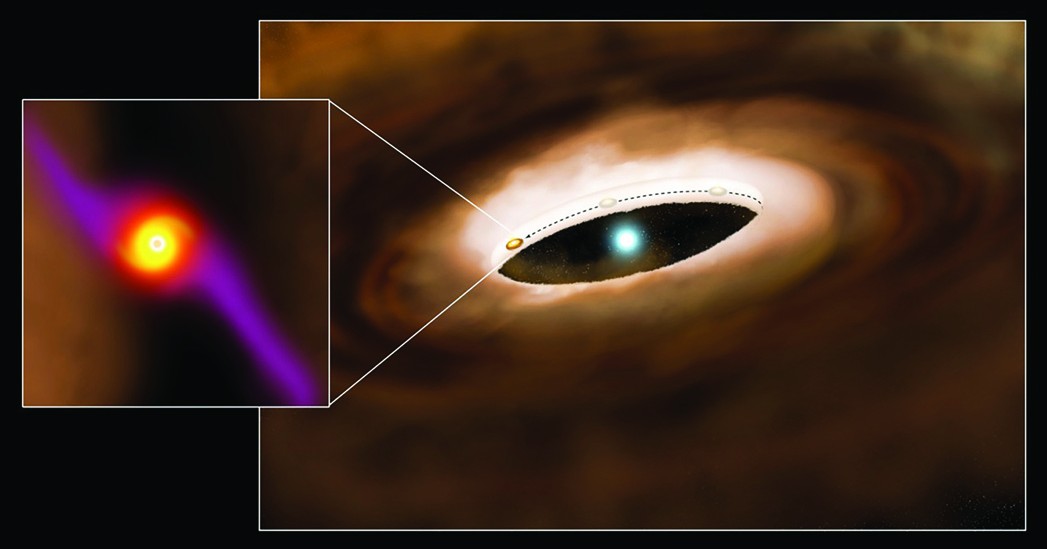from dusty chaos, a planet forms
by Paul Alongi

This artist’s conception shows the young massive star HD100546 with a planet forming in its surrounding disk. As gas and dust flow from the disk to the planet, the material surrounds the planet as a circumplanetary disk (inset). These rotating disks are believed to be the birthplaces of planetary moons. Sean Brittain and his collaborators have reported evidence for an orbiting source of carbon monoxide emission whose size is consistent with theoretical predictions for a circumplanetary disk. Observations over ten years traced the orbit of the forming planet from behind the near side of the circumstellar disk in 2003 to the far side of the disk in 2013. The observations provide a new way to study how planets form. Image credit: P. Marenfeld & NOAO/AURA/NSF.
Sean Brittain and his colleagues find a new way to watch the birth of planets.
The twinkling stars in the night sky may look peaceful here on Earth, but it’s chaos up there.
Some of those stars are surrounded by swirling clouds of gas, dust, and rocks that collapse into each other to form planets.
Given enough time and the right circumstances, the chaos will give way to order. A solar system like our own will begin to take shape, but exactly how that happens remains shrouded in mystery.
Maybe not for long.
Sean Brittain led an international team of scientists that discovered evidence strongly suggesting a planet is orbiting a star, known as HD100546, about 335 light years from Earth.
The team’s work, combined with previous research, could mark the first time astronomers have been able to directly watch multiple planets forming in sequence. It’s something astronomers have long believed happens but have never been able to see. Other solar systems that astronomers have observed are either fully developed or too far away to see in the kind of detail that HD100546 offers.
“This system is very close to Earth, relative to other disk systems,” Brittain says. “We’re able to study it at a level of detail that you can’t do with more distant stars. This is the first system where we’ve been able to do this.
“Once we really understand what’s going on, the tools that we are developing can then be applied to a larger number of systems that are more distant and harder to see.”
Signs of a gas giant
The star is about 2.5 times larger and 30 times brighter than the sun. It’s in the constellation Musca, or the Fly, and can be seen only from the Southern Hemisphere.
The “candidate planet” that Brittain has been watching might be at least three times the size of Jupiter and might be an uninhabitable gas giant. It would take more than four lifetimes to get there, even traveling at the speed of light.
Brittain made three trips to Chile as far back as 2006 to gather data for his research. He used telescopes at the Gemini Observatory and the European Southern Observatory.
The team reported its findings in The Astrophysical Journal. News outlets around the globe covered the discovery in at least four different languages.
Previous research by a different team that included some of the collaborators on the Brittain team found a collapsing blob of gas and dust that could condense into a planet in about one million years. That means astronomers believe they have found not one but two potential planets orbiting the star.
Mark Leising, the chair of Clemson’s astronomy and astrophysics department, says that Brittain’s collaborations with leading institutions around the world have raised the department’s international profile and contributed to discoveries “at the forefront of astronomy.”
“Astronomers are now very good at finding already-formed planets around many nearby stars, but it has been difficult to watch the planets in the process of forming,” Leising says. “Using very clever techniques and the most advanced telescopes on Earth, they have accomplished that.”
Fusing chemistry and physics
For Brittain, the path to the stars was through chemistry.
He received his bachelor of science in chemical physics from LeTourneau University in Texas and then headed to Notre Dame to study the foundations of quantum mechanics. But he found that the advisor he wanted was retiring and not accepting new graduate students. Brittain soon found another professor who was doing research into the organic chemistry of comets. He received his Ph.D. in 2004 and became a NASA-funded Michelson postdoctoral fellow at the National Optical Astronomy Observatory. Brittain came to Clemson University two years later.
Brittain’s chemistry background helped get him an early start on using high-resolution spectroscopy to study the formation of stars and planets. It was a relatively new technique early in his career, he says, and has played a major role in his research on HD100546.
The technique enabled the team to measure small changes in the position of the carbon monoxide emission. A source of excess carbon monoxide emission was detected that appears to vary in position and velocity. The variations are consistent with orbital motion around the star.
The favored hypothesis is that emission comes from a circumplanetary disk of gas orbiting a giant planet, Brittain says. “Another possibility is that we’re seeing the wake from tidal interactions between the object and the circumstellar disk of gas and dust orbiting the star,” he says.

Sean Brittain’s path to astronomy led through chemistry, and he has used a chemist’s tool, high-resolution spectroscopy, to study stars and planets. Photo by Craig Mahaffey.
Sean Brittain is an assistant professor of physics and astronomy in the College of Engineering and Science. Brittain served as lead author on the article in The Astrophysical Journal. Coauthors were John S. Carr of the Naval Research Laboratory in Washington, D.C.; Joan R. Najita of the National Optical Astronomy Observatory in Tucson, Arizona; and Sascha P. Quanz and Michael R. Meyer, both of ETH Zurich, Institute for Astronomy. Paul Alongi is a technical and features writer in the College of Engineering and Science.


